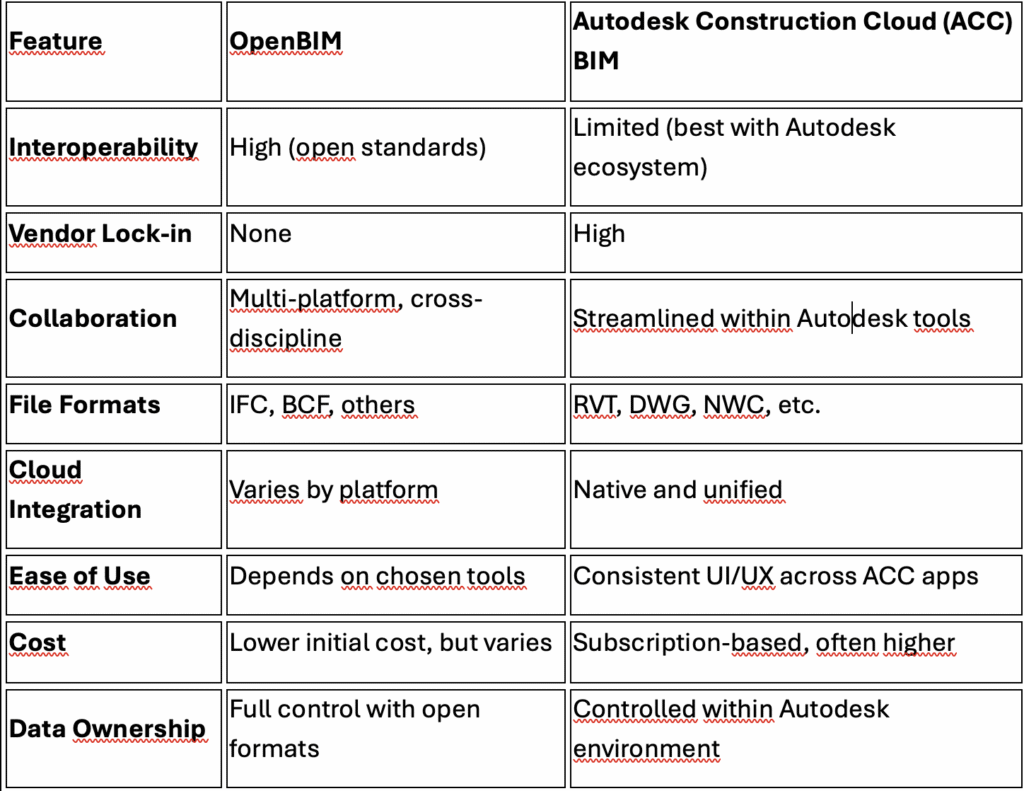Den digitala omvandlingen av byggbranschen har till stor del drivits på av Building Information Modeling (BIM). I takt med att BIM blir allt vanligare har de verktyg och plattformar som stöder BIM-arbetsflöden blivit allt mer varierade. Två framträdande metoder sticker ut: OpenBIM och Autodesk Construction Cloud BIM (ACC). Båda syftar till att effektivisera design-, samarbets- och byggprocesser, men de skiljer sig avsevärt åt när det gäller filosofi, implementering och interoperabilitet.
OpenBIM är en universell metod för design- och konstruktionssamarbete som använder öppna standarder som t.ex. IFC (Industry Foundation Classes), BCF (BIM Collaboration Format), och IDM (Information Delivery Manual). Det stöds av buildingSMART och ett brett utbud av programvaruleverantörer för att säkerställa att data inte låses fast i proprietära format.
Vad är OpenBIM?
OpenBIM är en universell metod för design- och konstruktionssamarbete som använder öppna standarder som t.ex. IFC (Industry Foundation Classes), BCF (BIM Collaboration Format), och IDM (Information Delivery Manual). Det stöds av buildingSMART och ett brett utbud av programvaruleverantörer för att säkerställa att data inte låses fast i proprietära format.
Viktiga egenskaper:
- Leverantörsneutral: OpenBIM är utvecklat kring öppna standarder och möjliggör interoperabilitet mellan olika BIM-verktyg som Archicad, Revit, Tekla och StreamBIM.
- Lång livslängd och flexibilitet: Säkerställer att data kan användas långsiktigt, oberoende av ett enskilt ekosystem för programvara.
- Fokus på samarbete: Stödjer multidisciplinära team med hjälp av olika verktyg.
- Öppenhet: Möjliggör granskning och kvalitetssäkring under hela projektets livscykel.
Fördelar:
- Frihet från leverantörslåsning
- Enklare samarbete mellan olika ekosystem för programvara
- Bättre dataportabilitet för långsiktig förvaltning av anläggningar
Vad är Autodesk Construction Cloud BIM (ACC)?
Autodesk Construction Cloud BIM (ACC) är en molnbaserad svit med verktyg för bygghantering som integreras tätt med Autodesks ekosystem för BIM-programvara, inklusive Revit, AutoCAD, Navisworks, och BIM 360. ACC BIM fokuserar på att förena arbetsflöden från design till konstruktion inom en och samma plattform.
Viktiga egenskaper:
- Sömlös integration med Autodesks verktyg: Inbyggt stöd för Revit-, Civil 3D- och AutoCAD-filer.
- Molnbaserat samarbete: Uppdateringar i realtid, spårning av problem, RFI:er och dokumentkontroll.
- Avancerade analyser och instrumentpaneler: Centraliserad datamiljö med insikter om kostnader, tidsplaner och kvalitet.
- Hantering av projektlivscykeln: Kopplar samman design, konstruktion och drift i en och samma plattform.
Fördelar:
- Mycket integrerad användarupplevelse för Autodesk-användare
- Snabb driftsättning med färdiga mallar
- Robust support och omfattande dokumentation
- Djupgående funktioner för samordning på fältet och modellbaserade arbetsflöden
Jämförelse direkt mot direkt

Vilken ska du välja?
- Välj OpenBIM om:
- Du måste samarbeta med flera olika intressenter med hjälp av olika BIM-verktyg.
- Långsiktig datatillgänglighet och öppna standarder är en prioritet.
- Du vill minska beroendet av en enda programvaruleverantör.
- Välj ACC BIM om:
- Ditt team använder redan Revit eller andra Autodesk-produkter, eller så har din öppna BIM-programvara inte någon Revit- eller Autodesk-plugin.
- Du vill ha en strömlinjeformad allt-i-ett-lösning med integrerad projektstyrning.
- Du värdesätter en polerad, tätt integrerad användarupplevelse.
Slutsats
OpenBIM och ACC BIM representerar två fundamentalt olika sätt att hantera BIM-arbetsflöden. OpenBIM förespråkar driftskompatibilitet och öppenhetmedan ACC BIM erbjuder en sluten men sammanhållen plattform skräddarsydda för Autodesk-användare. Vilket val som är rätt beror på dina projektmål, teamets sammansättning och din långsiktiga datastrategi.
Båda kan ge kraftfulla resultat - nyckeln är att anpassa teknikstrategin till organisationens behov och projektkrav.




